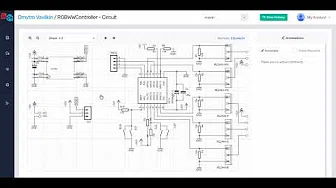Files
Scanning the repository...
Last update 3 years 1 week
by Pavel Mlčoch
| Files | |
|---|---|
| meta | |
| LICENSE | |
| README.md | |
| RPi_GPIO.sch | |
| RPi_Hat.cmp | |
| RPi_Hat.kicad_pcb | |
| RPi_Hat.lib | |
| RPi_Hat.net | |
| RPi_Hat.pro | |
| RPi_Hat.sch | |
| brd.png | |
| fp-info-cache | |
| sym-lib-table |
README.md% RPi B+ Hat
Raspberry Pi B+ Hat
Expansion Board
This is a project template for a Raspberry Pi B+ Hat.
This base project includes a PCB edge defined according to this specification. Both a thru-hole and a surface mount connector are provided, along with a different PCB edge for each. Just keep the PCB edge and connector type that you're using for your design and delete the others.
The component footprints used in this template are here.
The board outline looks like this:
Using the Template
To use the Raspberry Pi Hat template with the through-hole connector, do the following:
- Open the schematic. Remove the SMD connector, J1.
- Generate the schematic netlist.
- Generate the .cmp file. (The J2 connector will be the only component in it.)
- Open the PCB. Hover your mouse over the connector and hit e to edit it. Select the J1 SMD connector. In the Move and Place section of the Footprint Properties window, select the Free radio button. Then click OK. The SMD connector should now be unlocked so it can be removed.
- Read in the netlist from the schematic. In the Extra Footprints section of the Netlist dialog window, select the Delete radio button. Then click Read Current Netlist. The J1 SMD connector should disappear. Then click Close.
- Finally, delete the upper two arcs and the edge of the board outline.
To use the Raspberry Pi Hat template with the SMD connector, do the following:
- Open the schematic. Remove the through-hole connector, J2.
- Generate the schematic netlist.
- Generate the .cmp file. (The J1 connector will be the only component in it.)
- Open the PCB. Hover your mouse over the connector and hit e to edit it. Select the J2 through-hole connector. In the Move and Place section of the Footprint Properties window, select the Free radio button. Then click OK. The through-hole connector should now be unlocked so it can be removed.
- Read in the netlist from the schematic. In the Extra Footprints section of the Netlist dialog window, select the Delete radio button. Then click Read Current Netlist. The J2 through-hole connector should disappear. Then click Close.
- Finally, delete the lower two arcs and the edge of the board outline.
(c)2015-2021 Dave Vandenbout.








